Community inclusion, a solution for the pollution of the Las Vacas River
The Las Vacas River is the drainage of Guatemala City since the waste of the entire population, as well as hospitals and industry, flows into it.
The solutions are complex, but a non-governmental organization is based on community inclusion to recover, classify and transform the solid waste they gather from the river.
Traveling to San Antonio Las Flores, a small town 16 kilometers east of Guatemala City, is a call to reality. At the foot of the green and exuberant hills of Chinautla, the municipality to which this village belongs, the waters of the Las Vacas River constantly move while carrying tons and tons of solid, organic, and industrial waste coming from all the domestic and commercial activities of the inhabitants of the city.
On the banks of the river lives Patricia Gamboa, a 51-year-old woman, single mother, and grandmother who has had to make a living from whatever it takes to provide for her large family. “At home, we are ten people who live. I have had to work cleaning houses and collecting scrap metal in the river. There were days when I only earned 20 quetzales ($2.50) to feed my family,” she said.
In this area, it is common to see entire families dedicated to capturing and collecting potentially recyclable material. Men, women, and children face the risk of coming across waste that puts their health at risk, such as syringes, and suffering from diseases related to contact with water full of fecal material and other chemical and industrial contaminants.
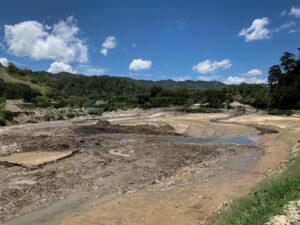
The Las Vacas River stopped harboring life to make way for tons and tons of waste. Photo: Jorge Rodriguez/Viatori
Although there is no exact data to back up this fact officially, the Las Vacas River is the largest supplier of pollutants to the Motagua, another river that some estimate carries up to 20,000 tons of garbage annually, or what is the same 2% of all plastic pollution in the world. The Ocean Cleanup (TOC), a Dutch organization, became interested in this situation and, at the beginning of last June, announced the installation of a fence 50 meters wide by 8 meters high, intending to stop the passage of all the garbage that moves through Las Vacas.
Boyan Slat, president and founder of TOC, explained that his idea is to stop plastic flow in the Las Vacas River to prevent it from reaching Motagua and ending up in the Caribbean Ocean of Honduras. TOC plans to collect as much plastic waste as possible, then take it back to the landfill, where much of the material initially washes into the river. “Right now, the fence is still an experimental system and not yet operational. Initially, large amounts of plastic were stopped, but the structure did not resist and was damaged due to the enormous pressure of the flood”, he said.
An endless cycle?
Get up, have breakfast, go to work, have lunch, and navigate the ocean of cars, motorcycles, and trucks. Go home, sleep. To do everything we do daily, we need energy sources (food, drink, electricity, gas, fuel) that allow us to carry out these daily tasks.
However, very few people think about the waste these energy sources generate and how complicated and laborious it is to transform them, let alone the impact they have on ecosystems and the lives of people like Doña Patricia. “I remember that before people used to fish for mojarra, we bathed and washed our clothes in the river, but suddenly, we began to see the river blacker and that it carried all kinds of garbage,” she lamented.
In Central America, including Guatemala, there are efforts to implement a culture of proper waste management. Next year, in August, the Government Decree 164-2021, Regulation for the Comprehensive Management of Waste and Common Solid Waste, will enter into force, and all people living in the country who produce waste must separate it at the time of its generation.
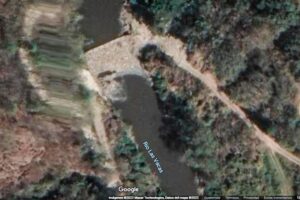
In San Antonio Las Flores, it is possible to see the accumulation of waste from satellite images. Photo: Google Maps
Before this comes to reality, the most important thing is to remind the entire population that current consumption habits harm natural resources and the natural life that inhabits them. “People are unaware that families also live on the banks of the rivers and suffer from all the mismanagement of waste that we, the capital’s inhabitants, cause. On the city streets, day after day, we see people throwing garbage from cars and buses. All of that ends up here in San Antonio Las Flores,” said María José Hernández, a Guatemalan biologist and scientist part of Biosfera GT, a non-governmental organization created to implement solutions related to the transformation of plastic and other waste from Guatemala City.
Separating waste is vital to prolonging the useful life of some materials. For instance, if a tetra pack or plastic container gets mixed with other materials such as oil or organic waste, it loses its recyclable value. All this material accumulates and causes uncontrollable garbage avalanches reaching Honduras’s Caribbean coast.
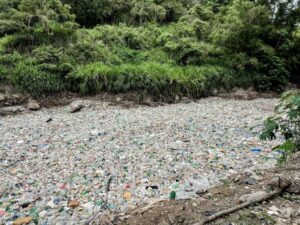
During the rainy season, Las Vacas River receives an unknown amount of tons of plastic, which is incorporated into the Motagua River and ends up in the Honduran Caribbean Sea. Photo: Biosphere GT
Transformation and community participation
After working for several years in research, Hernández understood that in a country like Guatemala, where barely 0.13% of GDP is invested in research and science, to have a more significant impact, he had to leave the world of reports and recommendations, and move on to more concrete and visible actions. “I came from pure science and research, and now I am working at the transformation plant, directing projects where you say “it is having an impact,” because you are seeing tons of solid waste managed here at the plant,” he said.
After more than a year of work, Biosfera GT opened a waste recovery and transformation plant in San Antonio Las Flores, an action that has brought complications. According to Mario Zea, Project Director of the NGO, the first thing that came to mind was to hire local people to support the collection and classification of the material, as is the case of Doña Patricia.
Research carried out before the plant’s opening detected that most households in San Antonio are families of single mothers who earn a living by selling food, clothing, and pottery. “We are giving work to the neediest people, who have 2, 3 or 4 children, and have never had a formal salary. More or less, 75% of our staff are women,” Zea said.
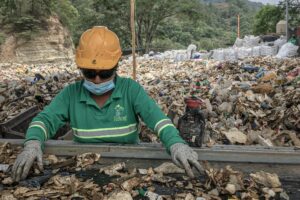
Biosfera GT employs about 50 permanent people, of which 75% are single mothers who now have the opportunity to earn a fixed salary that benefits their families. Photo: Jorge Rodriguez/Viator
This decision allowed them to employ these women and helped community leaders show their support for them, making their integration within the area easier. With the return of school activities, the members of Biosfera GT give environmental education talks to primary and secondary students and are about to hold reforestation days in the local cemetery, as well as in “La Laguna,” a waterspring located in San Antonio. Since February, they have managed to recover 60 tons of plastic, which they have sold to recyclers. The material that is not accepted is transformed into posts and plastic bricks that can be used in construction.
During this time, which Zea considers as “a learning period in waste management,” they have encountered a problem that is not very visible: the expanded polystyrene material, better known as duroport. This material represents almost half of all that is extracted from the river. For them, this presents a considerable problem since it is not a waste that can be reused.
One of the alternatives to this waste is to generate “some type of renewable energy,” but studies and tests are needed to know if it is viable. All they can do is transfer it to a cement production plant. “But we have to pay for the transportation, so we are seeking to ally ourselves with the manufacturers of duroport and make them aware so that they, being generators of the product, can finance that transportation,” he added.
With all this, both Zea and Hernández agree that the greatest satisfaction they feel in leading this initiative is knowing that their efforts are supporting the economic and social development of the families of San Antonio Las Flores.
“We didn’t imagine it would be like this. It is not an area with much development because there is no government or municipality support. The people live by collecting the scrap they take out of the river and the wood they use for cooking. The things they do to survive lack dignity because you look at the children working with their parents, with their feet stuck in the river, to survive daily. The impact we have had by giving them a formal and stable job reflects in the people,” Hernández said.
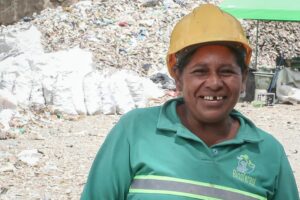
Patricia Gamboa is a San Antonio Las Flores resident. She collaborates in classifying solid waste extracted from the Las Vacas River, east of Guatemala City. Photo: Jorge Rodriguez/Viatori
And a clear example is Doña Patricia, who has been able to repair her house and improve food for her family. “Today, I buy her chicken, her milk, her cereal, and her bread for my children,” she said happily. Despite the improvement she has experienced in her personal life, she asks that all people, not just politicians, find definitive solutions to environmental pollution.
“I ask people not to throw garbage in the river, to classify their waste. It is difficult for Guatemalans because we live in a culture of “let the other do it,” but that is not the case. We all must participate in the care of our rivers,” she concluded.
